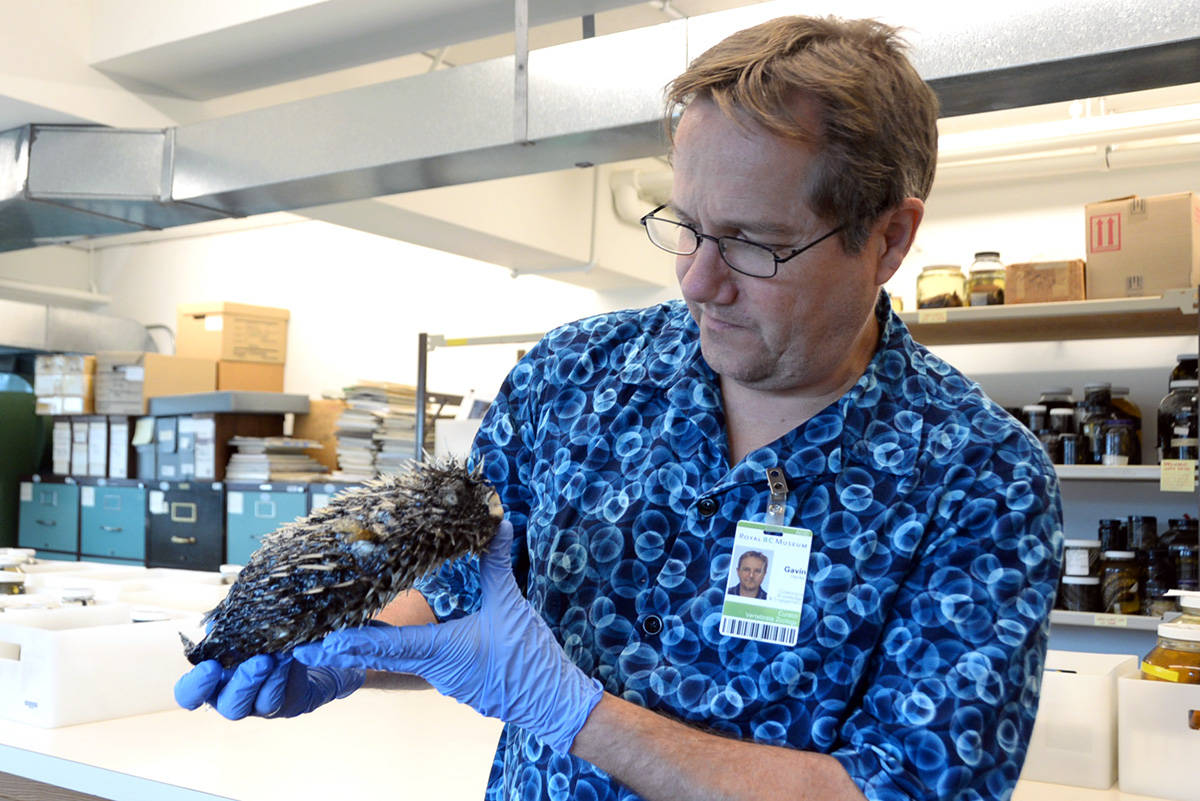Reaching excitedly into a water-filled container, Gavin Hanke, the Royal BC Museum’s curator of vertebrate zoology, carefully removes the body of poisonous porcupine fish and holds it proudly, water dripping from its razor-sharp quills.
Discovered for the first time in Canada on a Vancouver Island beach Oct. 5 – east of Jordan River – the sharp-spined fish has become an unlikely celebrity, wowing biologists, zoologists and the public with its unusual visit to the West Coast. The fish are normally found in temperate or tropical waters.
“It’s basically a puffer fish,” Hanke says. “They have tetrodotoxin so… you don’t want to eat one unless a licensed chef has prepared it.” Of the genus ‘diadon,’ the fish has a moveable spine and distinguishable mouth, it’s fused teeth give it the appearance of having a parrot’s beak in place of the simpler, pointed choppers found in most fish jaws.
READ ALSO: Hundreds of foreign species still washing up on B.C. coast, eight years after tsunami
The porcupine fish’s appearance on the West Coast – and reports of a second located on the same beach – is something Hanke chalks up to a “warm blob,” a surprisingly well-used term in the oceanography world for warm plumes of water that extend into typically colder zones. The ‘blobs’ are to thank for a number of rare specimens in the museum’s collection – in 2014 two surprising visitors – a trigger fish and a louvar – were discovered on Vancouver Island beaches.
To Hanke, these discoveries indicate that more non-native fish could be on their way to B.C. waters.
“We had one [warm blob] that ended in 2015 and now we have another … so if this is becoming the new norm, we could see a real change in diversity,” he says. “If it comes up two degrees, three degrees, this [porcupine fish] can survive here. It’s only a matter of time before populations get established.”
| A porcupine fish discovered washed up near the Jordan River mouth likely moved north in a "warm blob" of water from its normal habitat of shallow temperate and tropical seas. Now the fish specimen is in the hands of the Royal BC Museum where it will be catalogued and preserved. (Nina Grossman/News Staff) |
And Hanke says the public, or ‘citizen scientists’ play a large part in tracking species. Even without a body, a picture, date and location of a discovered fish can be significant.
“There’s all kinds of other fish, shallow-water species that could easily make it north to us. It’s a matter of people finding them – someone going fishing and going ‘what is this?’” he says. “These fish weren’t found by scientists, they were found by every day people in B.C.
“So that’s a huge contribution. They have their eyes on the beach, cause I can’t be everywhere.”
Stepping further into the back rooms of the Royal BC Museum brings you face to face with an assortment of wild and wonderful critters – Canadian geese and pheasants stacked among shelves of regional fowl, a bright-eyed caribou draped in a utility blanket. In one room, rows and rows of jars filled with fish specimens line metal shelving more than ten feet high.
In the larger fish and shark storage room, Hanke puts on elbow-length rubber gloves to pulls the 2014 louvar and trigger fish from formaldehyde-filled vats, showing off their perfectly preserved fins and armor-like scales. The only thing missing is colour – the specimens seem to take on some of the rusted, stomach-churning orange of their formaldehyde environment.
The vat containing a Mako shark, brought into the museum last year, is cloudier. It’s filled with oil from the shark’s liver. The formaldehyde in the shark vats, says Hanke, has to be replaced more regularly as a result.
READ ALSO: New photos help identify mystery creature found on Peninsula beach
Hanke’s love for marine vertebrate started outside a Bristol pet store, where as a child, he watched a zebra cichlid swim the lengths of its tank. Fishtailing from an early career in pet trading to an extensive education in zoology, invasive species and a PhD in evolutionary biology, he now finds himself one of the region’s authorities on unusual fish.
| A trigger fish found on the west coast of Vancouver Island in 2014 is one of many rare finds preserved at the Royal BC Museum. (Nina Grossman/News Staff) |
On a day to day basis Hanke could be studying anything from snail fish and cusk eels to Mola Mola and the aptly named ‘spiney eared assfish’ – a specimen that made headlines as much for its name as for its less than attractive appearance.
But he says it’s the the intertidal species and the unexciting, bottom-of the-food chain prey of B.C.’s sport fish that can really help identify climate change and habitat destruction.
One example is pricklebacks, a common intertidal fish.
“I figure when climate change hits us, it’s going to be the inter-tidal that gets hit the hardest because it will either warm up a lot more or dry out for longer [or] it might be wet and rainy,” he says. “Whatever extreme happens, it’s going to hit the inter-tidal really hard. A fish like this might be our first indicator.”
READ ALSO: Wildlife photography, orca exhibit coming soon to Victoria’s Royal BC Museum
The vast majority of the Royal BC Museum’s scaled specimens will never go on display for the public’s viewing, but as Hanke’s research proves, that’s only one aspect of the museum’s function.
“You’ve chemical signatures, DNA, presence and geography of the species present here in B.C. going back a hundred years or more,” he says. “They tell us what was here in the past [and] what’s here now and that allows us to detect change.
“The museum, in a sense, is a time machine.”
nina.grossman@blackpress.ca
Follow us on Instagram Like us on Facebook and follow us on Twitter.
